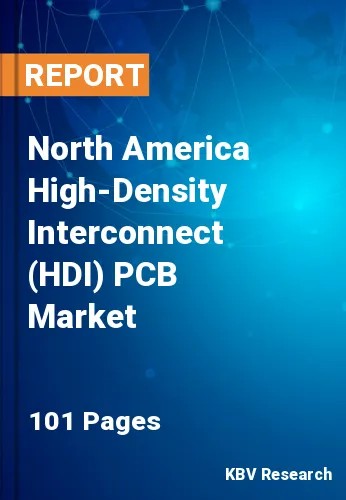The North America High-Density Interconnect (HDI) PCB Market would witness market growth of 10.2% CAGR during the forecast period (2023-2030).
The high-density interconnect (HDI) printed circuit boards (PCBs) boost the effectiveness of HDI boards in comparison to traditional PCBs while requiring fewer resources and boards in their construction. Additionally, these boards take less time to manufacture, which contributes to speedier production. The efficiency of the devices into which HDI boards are incorporated is increased by these functionalities. High efficiency, decreasing weight and size, and rising sales of consumer electronics are the main drivers of the market. These HDI PCBs have 400 m capture pads, 150 m smaller vias, and 100 m finer lines and gaps. Additionally, HDI PCBs have a connection pad density of over 20 pads/cm2, which is far higher than that of traditional PCBs.
In a number of end-use industries, such as communications, consumer electronics, and automotive, rising product demand is the main factor driving the market. The rapid product adoption of a variety of electronic products, including touch-screen gadgets, laptop computers, mobile phones, and digital cameras, can be credited to this. Additionally, the growing demand for high-performance devices and the trend toward miniaturizing electronic devices are boosting the market.
The evolution of mobile broadband services is being shaped by consumer expectations. There will be a need for creative solutions to address the anticipated increases in traffic (expected to be 10-100 times during the period of 2020–2030), a rise in the number of services and devices, as well as the desire for improved affordability and user experience. In any case, by the year 2025, there will be 50 billion connected gadgets on the Internet.
The region has a solid position in the market because top providers have boosted their investment in smart solutions for consumer electronics, IT, and telecom applications. The average American family, according to the US Environmental Protection Agency (EPA), employs 28 electronic gadgets, including e-readers, mobile phones, televisions, and personal computers. With the steady flood of new electronic devices, the demand for HDI PCBs will unavoidably increase. The average age of all Canadians was 41.1 years old, and there are seven million people who are over 65. Therefore, with the increasing need for HDIs for medical devices and consumer electronics, the region offers strong growth prospects to the market.
The US market dominated the North America High-Density Interconnect (HDI) PCB Market by Country in 2022 and would continue to be a dominant market till 2030; thereby, achieving a market value of $5,345.9 million by 2029. The Canada market is experiencing a CAGR of 12.7% during (2023 - 2030). Additionally, The Mexico market would exhibit a CAGR of 11.7% during (2023 - 2030).
Based on End User, the market is segmented into Consumer Electronics, Automotive, Industrial Electronics, IT & Telecommunications and Others. Based on Application, the market is segmented into Smartphone & Tablet, PC & Laptop, Smart Wearables and Others. Based on countries, the market is segmented into U.S., Mexico, Canada, and Rest of North America.
Free Valuable Insights: The Worldwide High-Density Interconnect (HDI) PCB Market is Projected to reach USD 26.9 Billion by 2030, at a CAGR of 10.9%
The market research report covers the analysis of key stake holders of the market. Key companies profiled in the report include MEIKO ELECTRONICS CO., LTD., DAP CORPORATION, AT & S Austria Technologie & Systemtechnik Aktiengesellschaft, Unitech Printed Circuit Board Corp., FICT LIMITED (Fujitsu Limited), TTM Technologies, Inc., UNIMICRON TECHNOLOGY CORP., NCAB Group AB, Ibiden Co., Ltd. and Sierra Circuits, Inc.
By End User
By Application
By Country
Our team of dedicated experts can provide you with attractive expansion opportunities for your business.

